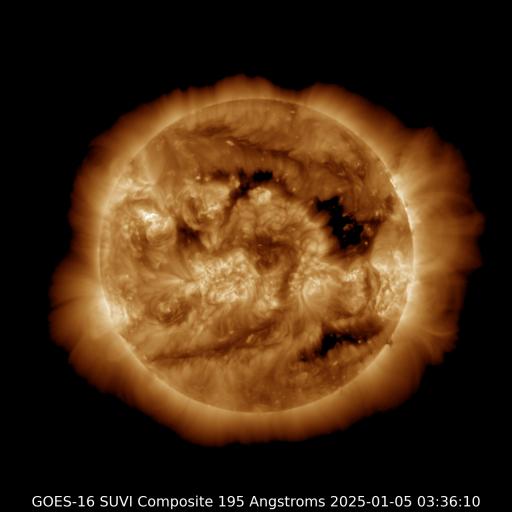Viewing archive of Monday, 7 February 2005
Solar activity report
Any mentioned solar flare in this report has a scaling factor applied by the Space Weather Prediction Center (SWPC). Because of the SWPC scaling factor, solar flares are reported as 42% smaller than for the science quality data. The scaling factor has been removed from our archived solar flare data to reflect the true physical units.
Report of Solar-Geophysical Activity 2005 Feb 07 2200 UTCPrepared by the NOAA © SWPC and processed by SpaceWeatherLive.com
Joint USAF/NOAA Report of Solar and Geophysical Activity
SDF Number 038 Issued at 2200Z on 07 Feb 2005IA. Analysis of Solar Active Regions and Activity from 06-2100Z to 07-2100Z
Solar activity remained at low levels. Newly numbered
Region 733 (S09E78) produced several low level C-class flares
during the period. There is a fair sized penumbral spot that has
just begun to rotate onto the visible disk. Due to the region's
proximity to the limb further analysis is pending. Region 732
(N09E57) was limited to the production of multiple B-class flares
over the period. Analysis indicates that there is a gamma magnetic
structure in both polarities of this active region. No other
regions were numbered today.
IB. Solar Activity Forecast
Solar activity is expected to be at
low levels. Regions 732 and 733 are both capable of producing
further C-class flare activity.
IIA. Geophysical Activity Summary 06-2100Z to 07-2100Z
The geomagnetic field was at quiet to minor storm levels. The ACE
spacecraft indicated that the onset of a recurrent high speed
coronal hole stream began around mid-day. Minor storm conditions
have persisted since 07/1430Z at middle and high latitudes.
IIB. Geophysical Activity Forecast
The geomagnetic field is
expected to be at unsettled to active levels with isolated minor
storm conditions possible through 8 February. Unsettled levels with
isolated active periods should dominate 9 and 10 February as the
geoeffective high speed coronal stream wanes.
III. Event Probabilities 08 Feb to 10 Feb
| Class M | 20% | 20% | 20% |
| Class X | 01% | 01% | 01% |
| Proton | 01% | 01% | 01% |
| PCAF | green | ||
IV. Penticton 10.7 cm Flux
Observed 07 Feb 103 Predicted 08 Feb-10 Feb 110/115/115 90 Day Mean 07 Feb 105
V. Geomagnetic A Indices
Observed Afr/Ap 06 Feb 006/009 Estimated Afr/Ap 07 Feb 015/020 Predicted Afr/Ap 08 Feb-10 Feb 012/015-010/010-010/010
VI. Geomagnetic Activity Probabilities 08 Feb to 10 Feb
| A. Middle Latitudes | |||
|---|---|---|---|
| Active | 25% | 20% | 20% |
| Minor storm | 10% | 05% | 05% |
| Major-severe storm | 05% | 01% | 01% |
| B. High Latitudes | |||
|---|---|---|---|
| Active | 35% | 20% | 20% |
| Minor storm | 15% | 05% | 05% |
| Major-severe storm | 05% | 01% | 01% |
All times in UTC
Latest news
Latest forum messages
Incoming & Unnumbered Active Regions 1673AR 4054 21AR4048 124Unspecified geomagnetic activity 2229Aurora photography hints for those of us with smartphones 66
More topicsSupport SpaceWeatherLive.com!
A lot of people come to SpaceWeatherLive to follow the Sun's activity or if there is aurora to be seen, but with more traffic comes higher server costs. Consider a donation if you enjoy SpaceWeatherLive so we can keep the website online!

Latest alerts
06:30 UTC - Type II Radio Emission
Begin Time: 08/04/2025 05:53 UTC Estimated Velocity: 456km/sec.
05:15 UTC - Hemispheric Power Index
The OVATION model predicts the Hemispheric Power Index to reach 50GW at 06:02 UTC
00:55 UTC - Coronal hole
A southern hemisphere coronal hole is facing Earth. Enhanced solar wind could arrive in ~3 days
Monday, 7 April 2025
20:45 UTC - Geomagnetic activity
Active geomagnetic conditions (Kp4) Threshold Reached: 20:39 UTC
17:33 UTC - Hemispheric Power Index
The OVATION model predicts the Hemispheric Power Index to reach 51GW at 18:18 UTC
Space weather facts
| Last X-flare | 2025/03/28 | X1.1 |
| Last M-flare | 2025/04/05 | M1.0 |
| Last geomagnetic storm | 2025/04/06 | Kp5 (G1) |
| Spotless days | |
|---|---|
| Last spotless day | 2022/06/08 |
| Monthly mean Sunspot Number | |
|---|---|
| March 2025 | 134.2 -20.4 |
| April 2025 | 151.3 +17.1 |
| Last 30 days | 135.2 -4.5 |




